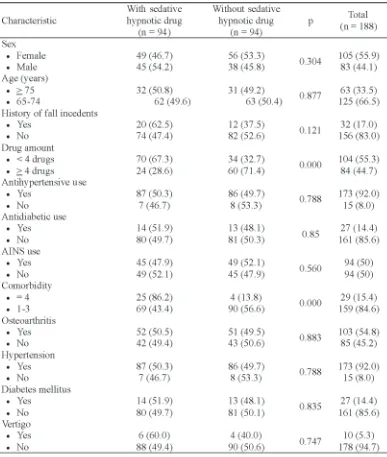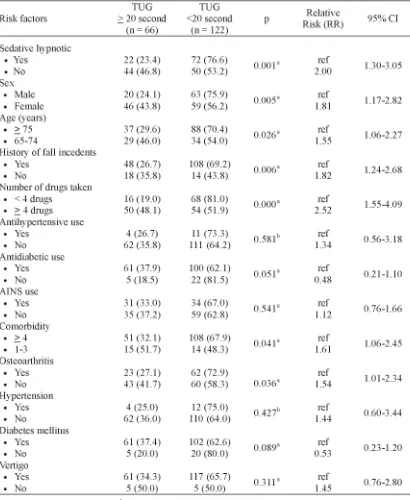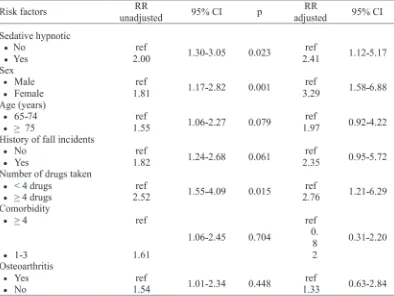* corresponding author: cristi dianamambo@gmail.com
Sedative hypnotics use as the risk factor
for fall incidents on geriatric patients
Christi Mambo1 Jarir At Thobari2, Woro Rukmi Pratiwi 2
1Department of Pharmacology and Therapy, Faculty of Medicine, Universitas Sam Ratulangi, Manado, 2Department of Pharmacology and Therapy, Faculty of Medicine, Universitas Gadjah Mada, Yogyakarta, Indonesia
ABSTRACT
Fall incident is one of geriatric syndromes that cause an increasing public health burden worldwide. The risk factors for falls incidents on geriatric patients have been identified included medication use. Benzodiazepine is a sedative hypnotic that found to be associated with an increase fall incidents. The aim of the study was to evaluate the influence of sedative hypnotics on the risk of fall incidents on geriatric patients. This was an observational study using cohort design involving 188 eligible geriatric patients comprising 94 patients who take sedative hypnotics and 94 patients who not. All pasients then underwent a test for functional mobility and fall risk using timed “up & go” test (TUG). The subjects who take ≤ 20 seconds to complete the TUG was considered to have low risk for fall incidents, whereas those who take >20 seconds was considered to have high risk for fall incidents. The results showed that the use of sedative hypnotics, sex, and number of drugs taken were associated with fall incidents on geriatric patients. Geriatric patients who use sedative hypnotics were 2.41 times higher at risk of fall incidents than those who not use sedative hypnotics (95%CI;1.12-5.17; p=0.023). Geriatric patients who take alprazolam were 2.78 times higher at risk of fall incidents compared to those who not take (95% CI: 1.49-5.19; p=0.028). Furthermore, female geriatric patients were 3.29 times higher at risk of fall incidents compared to male geriatic patients (95%CI: 1.58-6.88; p=0.001) and the use of ≥ 4 kinds of drugs were 2.76 times higher at risk of fall incidents compared to the use of <4 kinds of drugs (95%CI:1.21-6.29; p=0.015). In conclusion, sedative hypnotics is found to be a risk factor for fall incidents on geriatric patients.
ABSTRAK
p=0,015). Dapat disimpulkan, sedatif hipnotik ditemukan sebagai faktor risiko roboh pada pasien usia lanjut.
Keywords: fall incidents - geriatric patients - sedative hypnotic drugs – risk faktor – timed up and go test
INTRODUCTION
Aging is natural part of life that represents the process of becoming older or the accumulation of changes in person over time.1,2
In humans, aging refers to a multidimensional process of physical, psychological, and social changes. The geriatric population in the world, person ≥ 65 years, increases gradually in last decades due to rising life expectancy and/or declining birth rates.3 In Indonesia in 1971, the
geriatric population numbered 5.3 million (4.48%). It increased to be 8.0 million (5.45%) by 1980, 11.3 million (6.29%) by 1990, 14.4 million (7.18%) by 2000 and 24.0 million (9.77%) by 2010. Yogyakarta is a province with the largest geriatric population (13.04%) in Indonesia.4
The fast growth of elderly population worldwide potentially increases the health burden of the population. Fall incident is one of geriatric syndromes that cause an increasing public health burden worldwide.5 Fall incidents
in elderly people are approximately 35% in persons 65 years of age or older each year. Moreover two third of such cases the falls are recurrent during 6 months.6 Falls incidents
increases exponentially with age i.e. 30% in persons 65 years of age and over increases to 50% in persons 80 years of age and over.7 Falls
incidents account for approximately 10% of visits to the emergency department and 6% of urgent hospitalizations among elderly populations.8 Fall incidents are associated with
The risk factors for falls have been reported included age, sex, predisposing medical conditions such as Parkinson’s disease, stroke, incontinence, vision problems and medication use.10-12 Medications related to an increased
risk of fall incidents have been identified included sedative hypnotic, antihypertensive, diuretics, antiparkinson, antipsychotic, antidepressant, antihyperglycemic, non steroid antiinflammatory drugs (NSAID), and alcohol.12,13 Benzodiazepines is a sedative
hypnotic that found to be associated with an increase fall incidents. The benzodiazepines contribute up to 40% fall incidents in elderly patients, however a large number of these patients still being prescribed benzodia-zepines.13-15 This study was conducted to
evaluate the influence of sedative hypnotic on the risk of fall incidents in elderly patients in the Geriatrics Polyclinic, Department of Internal Medicine, Dr. Sardjito General Hospital, Yogyakarta.
MATERIALS AND METHODS
Subjects
participate in the study by signed an informed consent. The exclusion criteria are patients with difficulties to walk, using walking aids, and blind.
Procedure
Geriatric patients who attended in the Geriatric Polyclinic were selected. An explanation concerning the background, objectives and benefits of the study was given. Subjects who fulfilled the inclusion and exclusion criteria or their families were given an informed consent to be signed. Subjects were also given a questionnaire to be filled. The questionnaire consisted age, history of illnesses, sedative hypnotics and other drugs used. The use of sedative hypnotics was also gathered from medical records of the patients. Subjects were then divided into two groups. The first group was geriatric patients who use sedative hypnotics and the second group was geriatric patients who not use.
All subjects then underwent a test for functional mobility and fall risk using timed “up & go” test (TUG) as recommended by the American Geriatrics Society and the British Geriatric Society to predict the fall incidents.16,17 A standard chair with armrests
was used for all test. Subject was asked to stand up, using the armrests as necessary, walk past a line 3 meters a way, turn around and comeback and sit down in the chair. Subjects were timed from the point where their buttocks rose from the chair to when their buttocks touched the chair when returning to sitting. Sebject was asked to walk not run as quickly, but as safely as possible. The subjects who take d”20 seconds to complete the TUG was considered to have
low risk for falling, whereas those who take >20 seconds was considered to have high risk for falling.
Statistical analysis
Data were presented in terms of frequencies
or percentages and analyzed using a computer
software program. Univariate analysis was
employed to analyze the charactersitics of subjects. Bivariate analysis using Pearson Chi-square test or Fisher’s Exact test was conducted to evaluate the relationship between the sedative hypnotics use and other comorbid factors as risk factors fall incidents. Multivariate analysis using logistic regression analysis was conducted to evaluate the comorbid factors which influence relationship between the sedative hypnotics use and fall incidents.
RESULTS
TABLE 1. Baseline characteristics of subjects (n or %)
Bivariate analysis using Pearson Chi-square test or Fisher’s Exact test was conducted to evaluate the relationship between the sedative hypnotics use, comorbid factors and fall incidents. The results are presented in TABLE 2. Sedative hypnotic drug use, female patients,
TABLE 2. Bivariate analysis of risk factors of fall incidents in geriatric patients
Further multivariate analysis using logistic regression showed that the use of sedative hypnotics, sex, and number of drugs taken were associated with fall incidents on geriatric patients, whereas age, history of fall incidents,
Furthermore, female geriatric patients were 3.29 times higher at risk of fall incidents compared to male geriatic patients (95%CI: 1.58-6.88; p=0.001) and the use of ≥ 4 kinds of drugs
were 2.76 times higher at risk of fall incidents compared to the use of <4 kinds of drugs (95%CI:1.21-6.29; p=0.015).
TABLE 3. Multivariate analysis of risk factors of fall incidents in geriatric patients
Note. ref : reference, RR adjusted used logistic regression to evaluate risk factors with p-value <0.05 on bivariate analysis i.e. sedative hypnotics use, sex, age, history of fall incidents and number of drugs use, comorbidity and osteoarthritis
Bivariate analysis using Pearson Chi-square test was conducted to evaluate the relationship between kinds of sedative hypnotics use and risk of fall incidents. The results are presented in TABLE 4. The use of alprazolam significantly increased the risk of fall incidetns in geriatric patients, whereas the use od
TABLE 4. Bivariate analysis of the use of kinds of sedative hypnotics as the risk of fall incidents on geriatric patients
TABLE 5. Multivariate analysis of the use of alprazolam as the risk of fall incidents on geriatric patients
Note = ref : reference; RR adjusted used logistic regression to evaluate risk factors with p-value
<0.05 on bivariate analysis i.e. alprazolam.
Bivariate analysis using Fisher’s Exact test
was conducted to evaluate the relationship between duration of the sedative hypnotics use and risk of fall incidents. The results are
presented in TABLE 6. Durion of the sedative hypnotics use was not associated with fall incidents in geriatric patients.
DISCUSSION
Our study showed that the use of sedative hypnotics were found to be a risk factor for fall incidents. Geriatric patients who use sedative hypnotic were 2.42 times higher at risk of fall incidents than those who not use sedative hypnotic. The studies concerning the use of sedative hypnotics as a risk factor for fall incidents in geriatric patients have been reported by some authors with paralel results. Woolcott et al.11 reported that the use of sedative
hypnotics were associated with fall incidents in geriatric patients. The risk of fall incidents in geriatric patients who use sedative hypnotics was 2.41 timer higher than in those who not use sedative hypnotics (95% CI: 1.35-1.62). Moreover, the increase in risk of fall incidents in geriatric patients who use sedative hypnotics was also reported by Sorock and Shimkin15
(RR:1.53; 95% CI : 0.93- 2.52) and by Krauss
et al.16 (RR: 4.3; 95% CI: 1.6-11.5).
Benzodiazepines are sedative hypnotics that commonly used to treat sleeping disorders and anxiety problems in geriatric patients. The prevalence of benzodiazepines use is approximately 10-12%.17 Several studies have
been conducted to evaluate the association between benzodiazepines and falls incidents in geriatric patients. Most studies showed a significant association between the use of benzodiazepines and falls or fractures incidents.18-20 The higher risk of fall incidents
may due to decreased rate of metabolism of the benzodiazepines and due to greater susceptibility to central nervous system depression on geriatric patients.21,22 These cause
accumulation of the benzodiazepines in the body and may lead to excessive sedation with impaired psychomotor performance, ataxia,
Female geriatric patients were 3.29 times higher at risk of fall incidents than male patients in this study indicating that female sex as a risk factor for fall incidents. This result was similar with previous studies that showed a significant association between female sex and fall incidents in elderly. Bartlett et al.20 reported that
risk factors for falls were associated with statistically significant increases in the risk of receiving a new benzodiazepine prescription including being female (OR:1,20; 95%CI: 1.18-1.22). Buatois et al.23 reportet that female sex
as an independent determinant factor for recurrent falls (OR:1.62; 95%CI: 0.99-2.65). Elderly women much lose bone mass leading to markedly decreased bone mineral density and osteoporosis. Elderly women with low bone mineral densisty and osteoporosis are higher risk of fall.20,23,24
Furthermore, the study showed taking ≥ 4 kinds of drugs were 2.76 times higher at risk of fall incidents compared to taking <4 kinds of drugs (95%CI:1.21-6.29; p:0.015). Buatois et al.23 reportet taking ≥ 4 drugs per day as an
independent determinant factor for recurrent falls (OR:1.66; 95%CI: 1.06-2.60). Morover, Kuptniratsaikul et al.25 reported that taking e”4
drugs 0.52 time higher increased fall incidents compared to taking <4 drugs. Polypharmacy has been universally accepted as an independent factor associated with the risk of fall related injuries.26 Polypharmacy is often associated
with pointless or inappropriate prescriptions that increase the likelihood of patients, particularly the elderly, manifesting sedation, confusion, balance disorders and complications caused by pharmacological interactions.27
hypnotics are 2.41 times higher at risk of fall incidents than those who not take.
ACKNOWLEDGMENTS
We would like to thank Dr. Probosuseno, SpPD.K-Ger for his kind help and valuable professional assistance during study.
REFERENCES
1. Darmojo B. Teori proses menua. In: Hadi M dan Kris P editor. Ilmu kesehatan usia lanjut. Jakarta: Balai Penerbit FKUI, 2009: 3-9.
2. Bowen RL and Atwood CS. Living and dying for sex. Gerontology 2004; 50(5):265-90. doi: 10.1159/000079125
3. United Nations. World Population Ageing: 1950-2050, United Nations Population Division. [cited 2014, June 6]. Available from: http://www.un.org/ esa/population/ publications/worldageing 19502050/
4. Pusat Data dan Informasi, Kementrian Kesehatan Republik Indonesia. Gambaran kesehatan usia lanjut di Indonesia. Buletin Jendela Data dan Informasi Kesehatan 2013; 1:1-18.
5. Lawlor DA, Patel R, Ebrahim S. Association between falls in elderly women and chronic diseases and drug use: cross sectional study. BMJ 2003; 327:712.
6. King M. Fall incidents. In: Hazzard WR, Halter JB, Ouslander JG, Tinetti ME, Studenski S, High KP, Asthana S, editor. Hazzard’s geriatric medicine and gerontology. New York: Mc Graw Hill, 2009; 659-69.
7. Steinweg KK. The changing approach to falls in the elderly. Am Fam Physician 1997; 56 (7):1815– 23.
8. Tinetti ME. Preventing falls in elderly persons. N Engl J Med 2003; 348(1): 42–9.
9. Hartholt KA, Boyé NDA, van der Velder N, van Lieshout EMM, Polindera S, de Vries OJ, et al.
[Cost]effectiveness of withdrawal of fall-risk increasing drugs versus conservative treatment in older fallers: design of a multicenter randomized controlled trial (IMPROveFALL-study). BMC Geriatric. 2011; 11:48.http://www.biomedcentral. com/ 1471-2318/11/48
10. Mackintosh SFH, Goldie P & Hill K. Falls incidence and factors associated with falling in
older, community-dwelling, chronic stroke survivors (> 1 year after stroke) and matched controls. Aging Clin Exp Res 2005; 17:74–81. 11. Woolcott JC, Richardson KJ, Wiens MO, Patel
B, Marin J, Khan KM, et al. Meta-analysis of the impact of 9 medication classes on fall incidents in elderly persons. Arch Intern Med. 2009; 169(21):1952-60.
12. Shuto H, Imakyure O, Matsumoto J, Egawa T, Jiang Y, Hirakawa M, et al. Medication use as a risk factor for inpatient falls in an acute care hospital: a case-crossover study. Br J Clin Pharmacol 2010; 69(5):535–42.
13. Frels C, Williams P, Narayanan S, Gariballa SE. Iatrogenic causes of fall incidents in hospitalised elderly patients: a case-control study. Postgrad Med J. 2002; 78(922):487-9.
14. Stenbacka M, Jansson B, Leifman A, Romelsjö A. Association between use of sedatives or hypnotics, alcohol consumption, or other risk factors and a single injurious fall or multiple injurious fall incidents: a longitudinal general population study. Alcohol. 2002; 28(1):9-16.
15. Sorock GS, Shimkin EE. Benzodiazepine sedatives and the risk of falling in a community-dwelling elderly cohort. Arch Intern Med. 1988; 148(11):2441-4.
16. Krauss MJ, Evanoff B, Hitcho E, Ngugi KE, Dunagan WC, Fischer I, et al. A case-control study of patient, medication, and care-related risk factors for in patient fall incidents. J Gen Intern Med. 2005; 20(2):116-22.
17. Blazer D, Hybels C, Simonsick E, Hanlon J. Sedative, hypnotic, and antianxiety medication use in an aging cohort over ten years: a racial comparison. J Am Geriatr Soc. 2000; 48(9): 1073–9.
18. Hartikainen S, Lonnroos E, Louhivuori K. Medication as a risk factor for falls: critical systematic review. J Gerontol A Biol Sci Med Sci. 2007; 62(10): 1172–81.
19. Frels, C, Williams P, Narayanan S, Gariballa SE. 2002. Iatrogenic causes of falls in hospitalised elderly patients: a case-control study. Postgrad Med J. 2002; 78(922): 487-9.
21. Dailly E and Bourin M. The use of benzodiazepines in the aged patient: clinical and pharmacological considerations. Pak J Pharm Sci. 2008; 21(2):144-50.
22. Sithamparanathan K, Sadera A, Leung L. Adverse effects of benzodiazepine use in elderly people: a meta-analysis. Asian J Gerontol Geriatr. 2012; 7: 107–11
23. Buatois S, Perret-guillaume C, Gueguen R, Miget P, Perrin P, Benetos A, et al. A Simple clinical scale to stratify risk of recurrent fall incidents in community- and older. Phys Ther. 2010; 90(4):550-60.
24. Kamide N, Shiba Y, Shibata H. Effects on balance, fall incidents, and bone mineral density of a home-based exercise program without home visits in community-dwelling elderly women: a randomized controlled trial. J Physiol Anthropol. 2009; 28(3):115-22.
25. Kuptniratsaikul V, Praditsuwan R, Assantachai P, Ploypetch T, Pooliam J, Udompunturak S. Effectiveness of simple balancing training program in elderly patients with history of frequent fall incidents. Clin Interv Aging. 2011; 6:111-7.
26. Baranzini F, Diurni M, Ceccon F, Poloni N, Cazzamalli S, Costantini C, et al. Fall-related injuries in a nursing home setting: is polypharmacy a risk factor? BMC Health Serv Res. 2009; 11(9):1-10.



